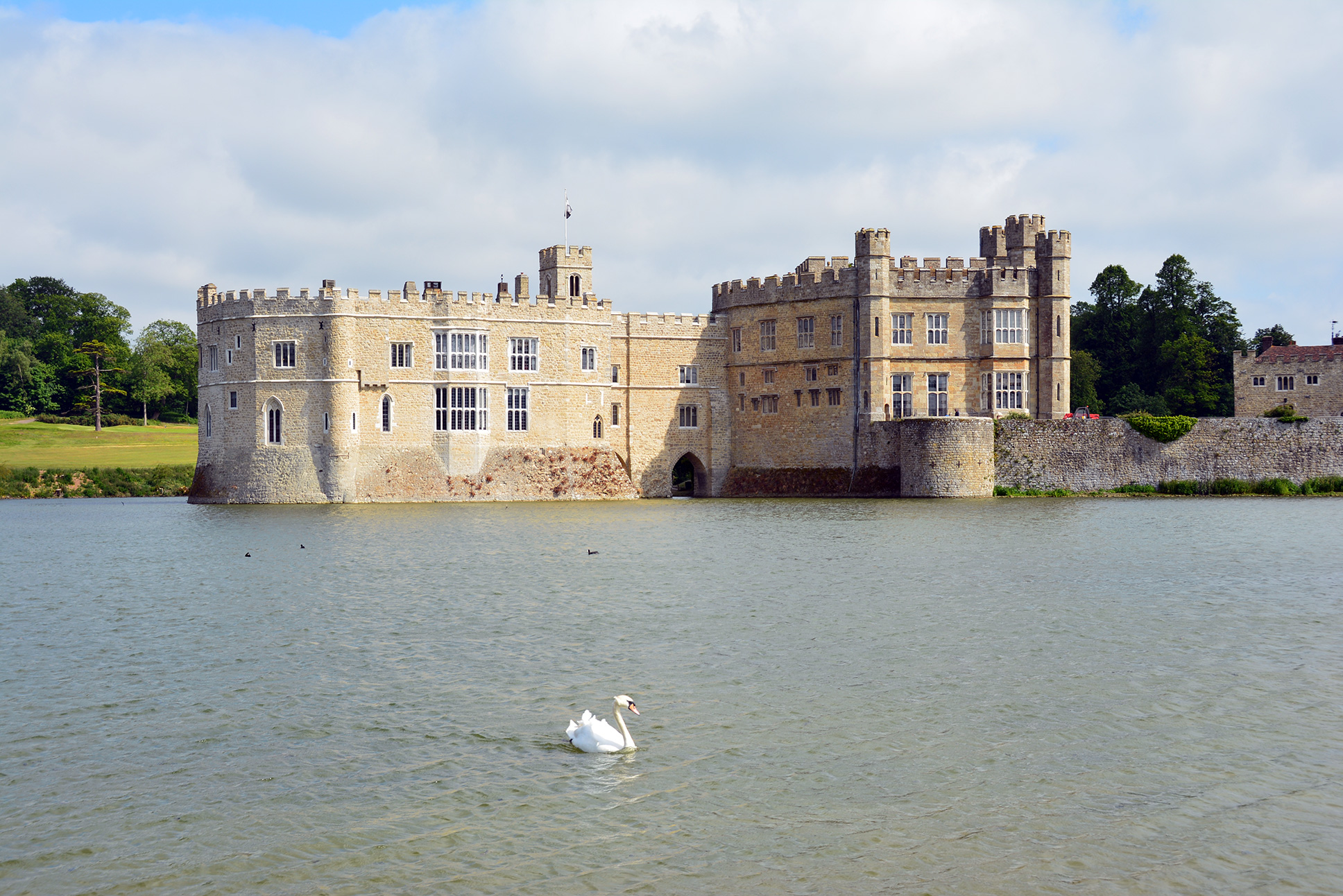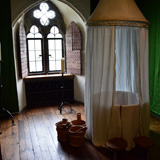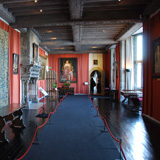History
Leeds Castle was built around 1119 by Robert de Crevecoeur (Robert the broken hearted) with a keep located where the present-day Gloriette resides. The castle is built atop two small islands in the lake formed by the River Len, giving it extra moat protection. Its location in Kent strategically defends the country from invasions from potential invaders from the southern coast.
After the Battle of Evesham in 1265, the family fortunes declined. The de Crevecoeur family was forced to yield the castle to Sir Roger de Leyburn, whose son, William, conveyed the castle to King Edward I and his queen Eleanor of Castile, in 1278. This began a long stretch of royal ownership of the castle.

Edward and Eleanor enjoyed the castle and stayed there often. Edward and Eleanor began many refinements at the castle, including the Gloriette, glass windows, the Queen's Baths, one of the first Bathhouses in England, and a barbican and fortified mill. Eleanor died in 1290, and in 1299 Edward married Margaret, sister of King Phillip III of France. Edward and Margaret spent their honeymoon at Leeds Castle. The King granted Leeds Castle to Margaret shortly after their honeymoon, starting a pattern whereby the castle often became part of the dower of the Queens of England.
In 1318, Edward II gave Leeds Castle to Bartholomew Badlesmere in appreciation for his loyal service to the crown. But Badlesmere would later join a rebellion against the King. In October 1321, Edward's wife, Queen Isabella, the she-wolf of France, arrived at Leeds Castle to rest and take refuge. Isabella was denied access by Margaret Badlesmere while her husband Bartholomew was away. Archers from within the castle fired arrows at the royal party, killing six of the party. Not pleased, King Edward and an army besieged the castle and took possession within a week. Not long after, Bartholomew was captured and beheaded.
In 1403, King Henry IV granted Leeds Castle to his second wife, Queen Joan of Navarre. In 1419, her stepson, Henry V, accused her of witchcraft and had her imprisoned. She was kept at Leeds Castle for four years. Eventually, she was quietly released.
By the start of the 16th century, Leeds Castle had fallen into disrepair after decades of neglect; until the time of the Tudor Dynasty, when Henry VIII and his entourage stopped at Leeds Castle on his way to meet Francis I of France at the Field of the Cloth of Gold in 1520. Henry started major works on Leeds Castle in 1517 to prepare it for their stay. The upper story of the Gloriette was added, which included a private bed chamber and bathroom for the queen. The Maiden's Tower was added for the queen's ladies-in-waiting. By 1552, having lost most of their possessions in France, the English royals had no further need of Leeds Castle and granted it to Sir Anthony St. Leger of Ulcombe, ending the royal connection with the castle.
In the mid-1660s, Leeds Castle was leased to the government by then-owner Lord John Culpepper. The castle was used to retain French and Dutch prisoners who occupied the Gloriette and, on one occasion, set fire to it, causing damage that remained until 1822.
In 1926, Leeds Castle was bought by Lady Olive Baillie, who restored the run-down castle into a stately home. The castle experienced a renaissance and hosted lavish parties, entertaining celebrities, ambassadors, and royals. In 1939, World War II started, and Leeds Castle had to adapt to a new way of life. The family moved into the Gloriette, and the moat was drained, so the castle could not be as easily identified by German pilots flying over the Kent countryside. Leeds Castle also served as an emergency hospital during the war. The castle survived the war undamaged, with a few bombs landing within the castle grounds. When Lady Baillie died in 1974, she left the castle and its surrounding park to the Leeds Castle Foundation, which she started towards the end of her life to ensure Leeds Castle would endure.
Castle Highlights
Leeds Castle has come to be known as "The Loveliest Castle in England," given its picturesque setting on two islands in the Kent countryside. I have visited the castle in the dead of winter and the height of summer, and it's a magical place at any time of year and lovely indeed.
It's also known as the "Ladies Castle," given the number of Queens and influential women who have had a hand in its history and evolution. The interior of the castle can be visited by self-guided tour. The Gloriette is the castle's highlight, with its Tudor-style furnishings and paintings. Having been built for Queen Catherine, the Queen's Room, Queen's Bathroom, and Queen's Gallery, all give a good representation of what life was like during the reign of Henry VIII.
King Henry VIII's Banqueting Hall is also impressive, measuring over 73 feet long. It contains essential paintings, sculptures, and the earliest known Enghien tapestry, retaining the town's and weaver's marks, dating from between 1513 and 1535.
The Maiden's Tower is built on the courtyard between the gatehouse and New Castle that leads to the Gloriette. Today the Maiden's Tower houses a dog collar museum.
The grounds of Leeds Castle are massive, with lots to see and do. There is an aviary, hedge maze, grotto, and formal gardens to explore. There is also a falconry area where falconry displays take place. A small train takes visitors from the car park entrance to the castle, but I recommend walking back to the entrance to take in the views of the castle from the edge of the moat. With black and white swans in the moat and reflections of the castle on the water, this gives the castle a fairytale feel and undoubtedly where it earns the title of "The Loveliest Castle in England." Set aside a whole day to explore Leeds Castle.
Leeds Castle is also haunted.


